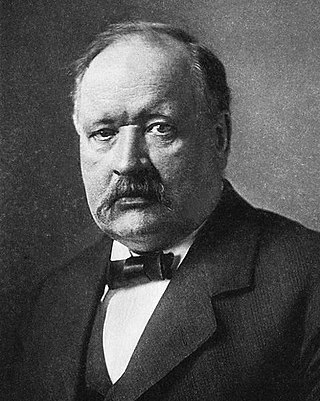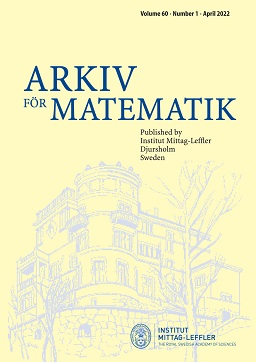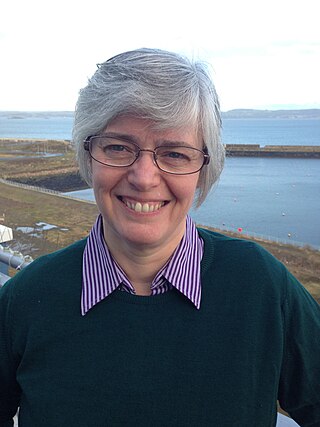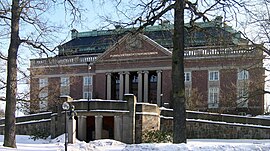
Svante August Arrhenius was a Swedish scientist. Originally a physicist, but often referred to as a chemist, Arrhenius was one of the founders of the science of physical chemistry. He received the Nobel Prize for Chemistry in 1903, becoming the first Swedish Nobel laureate. In 1905, he became the director of the Nobel Institute, where he remained until his death.
The Royal Academies are independent organizations, founded on Royal command, that act to promote the arts, culture, and science in Sweden. The Swedish Academy and Academy of Sciences are also responsible for the selection of Nobel Prize laureates in Literature, Physics, Chemistry, and the Prize in Economic Sciences. Also included in the Royal Academies are scientific societies that were granted Royal Charters.

Allvar Gullstrand was a Swedish ophthalmologist and optician.
The Crafoord Prize is an annual science prize established in 1980 by Holger Crafoord, a Swedish industrialist, and his wife Anna-Greta Crafoord. The Prize is awarded in partnership between the Royal Swedish Academy of Sciences and the Crafoord Foundation in Lund. The Academy is responsible for selecting the Crafoord Laureates. The prize is awarded in four categories: astronomy and mathematics; geosciences; biosciences, with particular emphasis on ecology; and polyarthritis, the disease from which Holger severely suffered in his last years.
The Gregori Aminoff Prize is an international prize awarded since 1979 by the Royal Swedish Academy of Sciences in the field of crystallography, rewarding "a documented, individual contribution in the field of crystallography, including areas concerned with the dynamics of the formation and dissolution of crystal structures. Some preference should be shown for work evincing elegance in the approach to the problem."

Physica Scripta is an international scientific journal for experimental and theoretical physics. It was established in 1970 as the successor of Arkiv för Fysik and published by the Royal Swedish Academy of Sciences (KVA). Since 2006, it has been published by IOP Publishing with the endorsement of the KVA. The journal covers both experimental and theoretical physics, with an accent on atomic, molecular and optical physics, plasma physics, condensed matter physics and mathematical physics.

The Department of Physics in Lund is a department that belongs to both the Faculty of Natural Sciences and the Faculty of Engineering at Lund University. The main goals are to expand the understanding of physics, its applications and to share scientific progress to new generations. Research is conducted in most of the physics subdivisions. The department also offers courses and a Masters's degree programs in pure physics and provides physics education for the Master of Science in Engineering programs.

The Nobel Memorial Prize in Economic Sciences, officially the Sveriges Riksbank Prize in Economic Sciences in Memory of Alfred Nobel, is an economics award funded by Sveriges Riksbank and administered by the Nobel Foundation.

The Nobel Prize in Chemistry is awarded annually by the Royal Swedish Academy of Sciences to scientists in the various fields of chemistry. It is one of the five Nobel Prizes established by the will of Alfred Nobel in 1895, awarded for outstanding contributions in chemistry, physics, literature, peace, and physiology or medicine. This award is administered by the Nobel Foundation, and awarded by the Royal Swedish Academy of Sciences on proposal of the Nobel Committee for Chemistry which consists of five members elected by the Academy. The award is presented in Stockholm at an annual ceremony on 10 December, the anniversary of Nobel's death.
Arkiv för matematik, astronomi och fysik was a scientific journal edited by the Royal Swedish Academy of Sciences. It covered mathematics, astronomy and physics.

The Arkiv för Matematik is a biannual peer-reviewed open-access scientific journal covering mathematics. The journal was established in 1949 when Arkiv för matematik, astronomi och fysik was split into separate journals, and is currently published by the International Press of Boston on behalf of the Institut Mittag-Leffler of the Royal Swedish Academy of Sciences. The current Editor-in-Chief is Hans Ringström.
Tommy Ohlsson is a Swedish physicist. He is a full professor in theoretical physics with specialization in elementary particle physics at the Royal Institute of Technology (KTH) in Stockholm, Sweden, situated at the AlbaNova University Center. His research field is theoretical particle physics, particularly neutrino physics and physics beyond the so-called Standard Model. He is an author of around hundred scientific publications and one textbook. He has also written a popular science text about the theory of special relativity at Nobelprize.org.

Eleanor Elizabeth Bryce Campbell FRSE FRS FRSC FInstP is a Scottish scientist who holds the Chair of Chemistry at the University of Edinburgh.

Anne Geneviève L'Huillier is a French physicist, and professor of atomic physics at Lund University in Sweden.

Krister Holmberg, born 1946, is a Swedish chemist.

Børge Bak, Knight of the Order of the Dannebrog 1st Class, was a Danish polymath, inventor, violinist, chemist and professor of molecular spectroscopy at the University of Copenhagen, best known for his early contributions to the field of Molecular Spectroscopy. Bak travelled widely as a visiting professor, including to Stanford University (1958), the University of California, Berkeley (1969), Columbia University in the City of New York, and the University of Bologna (1976). He served as a nominator to the Nobel Committee for Chemistry and played an instrumental role in the 1991 Nobel Prize in Chemistry being awarded to Richard R. Ernst for his "contributions to the development of the methodology of high resolution nuclear magnetic resonance (NMR) spectroscopy".

Lars Ivar Samuelson is a Swedish physicist and professor in nanotechnology and semiconductor electronics at Lund University.
Claes Fahlander is a Swedish physicist. After having graduated from Gävle in 1967, he joined Uppsala University, where he obtained his bachelor's degree in mathematics and physics in 1972. He became a Ph.D. in nuclear physics in 1977, and a teacher in 1982. Between 1979 and 1982 he worked at Australian National University in Canberra, and in the next decade he was active at Uppsala University. From 1995 to 1997 he did a sabbatical as a researcher at the Laboratori Nazionali di Legnaro in Italy, and on 1 July 1996 he succeeded Hans Ryde as professor of Cosmic and Subatomic Physics at Department of Physics at Lund University.
The Sjöberg Prize is an award aimed at individuals or research groups that have made significant contributions to cancer research. The prize, which is international, is planned to be awarded annually. It consists of a 100,000 US dollars of free disposal and 900,000 dollars to fund future research making up a total of one million US dollars. The prize money increases to counteract inflation. The Prize is funded by The Sjöberg Foundation, and the Royal Swedish Academy of Sciences is responsible for deciding upon the Sjöberg Laureates. The Foundation was founded in 2016, and the first prize was announced on 14 February 2017.















